Ultimate 2025 Toy Guide: Best Gifts for Kids Ages 1-4
Ultimate 2025 Toy Guide: Best Gifts for Kids Ages 1-4
by Susie Beghin, RECE, Author, Founder of Alpha’s Discovery Kids and The Raising Bright Early Learners Program
The holiday season is here, and so is the search for the perfect gift! Whether you’re a parent, grandparent, or friend to a little one, choosing the right toy can be both exciting and overwhelming. The best toys do more than entertain—they spark curiosity, build skills, and support your child’s growth in every way. That’s why I’ve created the Ultimate 2025 Toy Guide for Ages 1–4, featuring thoughtfully selected toys that inspire creativity, encourage development, and make playtime meaningful. Each recommendation is rooted in the ideas from my book Parents Learn to Play Too, which is filled with playful ways to support your child’s learning and development at every stage.
Whether you’re searching for engaging holiday presents or simply looking to add a few more tools to your parenting toolkit, this guide has everything you need for play-based learning!
Toys for 1-Year-Olds
At one year old, children are in full exploration mode, using their senses to understand the world and developing essential motor and problem-solving skills. Each toy in this category is designed to engage their curiosity and build foundational skills for future learning.
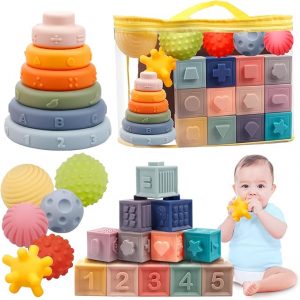
- Stacking Toys
Skill Focus: Fine motor skills, hand-eye coordination, spatial reasoning
This 3-in-1 stacking toy set includes 12 colorful soft blocks, 6 stacking rings, and 6 textured sensory balls designed to grow with your child. Perfect for ages 1 and up, these learning-inspired toys help little ones explore colors, shapes, textures, and numbers while strengthening fine motor skills and hand-eye coordination. Each block features adorable animals, fruits, and geometric patterns that encourage sensory exploration and early learning. Made from soft, chewable material, these toys double as safe teething aids and can even be used as fun bath toys that float and squirt water. Complete with a convenient storage bag, this vibrant set makes a thoughtful and educational gift for the holidays.  Musical Instrument Set
Musical Instrument Set
Skill Focus: Auditory processing, rhythm, coordinationThe perfect first instrument set for your 1-year-old! This engaging collection introduces little ones to the joy of music through hands-on exploration of sound and rhythm. Each instrument is designed for small hands, making it easy for toddlers to shake, tap, and play while discovering unique tones and patterns. As your child grows, this set continues to support their development—enhancing auditory awareness, coordination, creativity, and rhythm, all of which lay the foundation for language and early learning. A wonderful way to inspire a lifelong love of music that grows right along with your child!- Spike – The Fine Motor Hedgehog
Skill Focus: Cognitive skills, Fine Motor Skills, Concentration
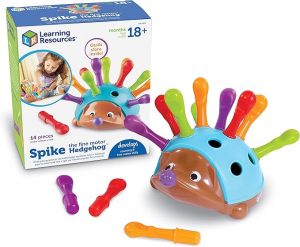 This adorable hedgehog is the perfect first fine motor toy for 1-year-olds! The colorful, easy-grip quills help little hands strengthen muscles and improve hand-eye coordination as children remove and place each piece into the hedgehog’s back. This toy is sure to keep your child engaged and increase attention span while working on necessary fine motor control. Designed to grow with your child, it starts as a fun sensory toy for toddlers and later introduces color recognition, counting, and simple patterns for preschool learning. The textured quills provide a delightful sensory experience, encouraging focus and tactile exploration, while the numbered holes naturally support early math and cognitive skills. Plus, the smart built-in storage keeps all 12 quills neatly inside the hedgehog—making cleanup quick and playtime ready anytime, anywhere!
This adorable hedgehog is the perfect first fine motor toy for 1-year-olds! The colorful, easy-grip quills help little hands strengthen muscles and improve hand-eye coordination as children remove and place each piece into the hedgehog’s back. This toy is sure to keep your child engaged and increase attention span while working on necessary fine motor control. Designed to grow with your child, it starts as a fun sensory toy for toddlers and later introduces color recognition, counting, and simple patterns for preschool learning. The textured quills provide a delightful sensory experience, encouraging focus and tactile exploration, while the numbered holes naturally support early math and cognitive skills. Plus, the smart built-in storage keeps all 12 quills neatly inside the hedgehog—making cleanup quick and playtime ready anytime, anywhere! - Cozy Coupe Car
Skill Focus: Gross motor skills, spatial awareness
 The Cozy Coupe is a classic that has stood the test of time! Perfect for outdoor or indoor play, it gives toddlers a chance to improve their gross motor skills by pushing, scooting, and maneuvering. It also promotes independence as children learn to steer and navigate around obstacles.
The Cozy Coupe is a classic that has stood the test of time! Perfect for outdoor or indoor play, it gives toddlers a chance to improve their gross motor skills by pushing, scooting, and maneuvering. It also promotes independence as children learn to steer and navigate around obstacles. - Hammer Toy
Skill Focus: Cause and effect, hand-eye coordination
 This hammer toy brings endless fun as toddlers hammer balls through holes and watch them reappear. It’s perfect for developing an understanding of cause and effect and builds hand-eye coordination with every tap. It’s an interactive way to teach the basics of physics while keeping little hands active.
This hammer toy brings endless fun as toddlers hammer balls through holes and watch them reappear. It’s perfect for developing an understanding of cause and effect and builds hand-eye coordination with every tap. It’s an interactive way to teach the basics of physics while keeping little hands active.
Toys for 2-Year-Olds
Two-year-olds are primed for pretend play and early cognitive challenges. The toys in this age group introduce them to skills like sorting, counting, and imaginative play, expanding their understanding of the world around them.
- Grocery Cart
Skill Focus: Dramatic play, fine motor skills
 This engaging grocery cart is the perfect pretend play companion for your little shopper! Designed to spark imagination, it lets toddlers explore real-life experiences like shopping, sorting, and organizing while having endless fun. The set includes colorful matching puzzles that introduce early math concepts such as counting, sorting, and pattern recognition, helping to build foundational cognitive skills. As children push, load, and unload the cart, they strengthen fine motor coordination, balance, and spatial awareness. Beyond skill-building, pretend play encourages communication, cooperation, and problem-solving as little ones role-play shopping trips with family or friends. Durable, bright, and perfectly sized for toddlers, this toy grows with your child—turning everyday play into meaningful learning moments filled with creativity and discovery.
This engaging grocery cart is the perfect pretend play companion for your little shopper! Designed to spark imagination, it lets toddlers explore real-life experiences like shopping, sorting, and organizing while having endless fun. The set includes colorful matching puzzles that introduce early math concepts such as counting, sorting, and pattern recognition, helping to build foundational cognitive skills. As children push, load, and unload the cart, they strengthen fine motor coordination, balance, and spatial awareness. Beyond skill-building, pretend play encourages communication, cooperation, and problem-solving as little ones role-play shopping trips with family or friends. Durable, bright, and perfectly sized for toddlers, this toy grows with your child—turning everyday play into meaningful learning moments filled with creativity and discovery. - Cash Register Skill Focus: Early math skills, fine motor skills, STEAM skills
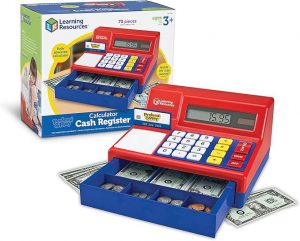 Perfect for curious two-year-olds who love to press buttons and explore cause and effect! This playful cash register introduces early number recognition and counting in a hands-on, engaging way. The working drawer and chunky coins provide a fun “fill and dump” experience that toddlers naturally enjoy, helping to strengthen fine motor skills, hand-eye coordination, and problem-solving. With every button press and coin exchange, little ones practice real-world play while building confidence and early math foundations through imaginative shopping adventures.
Perfect for curious two-year-olds who love to press buttons and explore cause and effect! This playful cash register introduces early number recognition and counting in a hands-on, engaging way. The working drawer and chunky coins provide a fun “fill and dump” experience that toddlers naturally enjoy, helping to strengthen fine motor skills, hand-eye coordination, and problem-solving. With every button press and coin exchange, little ones practice real-world play while building confidence and early math foundations through imaginative shopping adventures. - Wooden Block Set
Skill Focus: Problem-solving, creativity, STEAM Skills
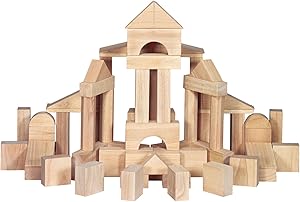 This timeless block set is perfect for open-ended play, allowing toddlers to build, stack, and knockdown structures. Building with blocks promotes problem-solving, hand strength, and spatial awareness, supporting more complex creative play as they grow. I particularly like the Melissa and Doug set because there are a good number of blocks with various shapes and sizes. This is a good investment which you can build on as they grow.
This timeless block set is perfect for open-ended play, allowing toddlers to build, stack, and knockdown structures. Building with blocks promotes problem-solving, hand strength, and spatial awareness, supporting more complex creative play as they grow. I particularly like the Melissa and Doug set because there are a good number of blocks with various shapes and sizes. This is a good investment which you can build on as they grow. - Doctor Kit
Skill Focus: Social-emotional skills, imaginative play
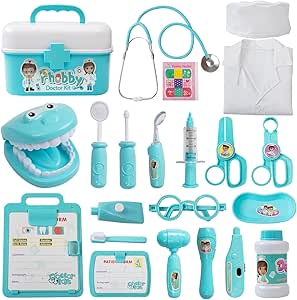 Toddlers love to imitate grown-ups, and this doctor kit gives them the perfect opportunity to step into the role of a caring helper. As they pretend to check heartbeats, give “checkups,” and make others feel better, children naturally develop empathy, imagination, and an understanding of social roles. This engaging set includes a real working stethoscope along with dentist tools for added variety, encouraging even more creative play. Plus, the sturdy carrying case keeps all the pieces neatly organized, making cleanup simple and playtime easy to take anywhere.
Toddlers love to imitate grown-ups, and this doctor kit gives them the perfect opportunity to step into the role of a caring helper. As they pretend to check heartbeats, give “checkups,” and make others feel better, children naturally develop empathy, imagination, and an understanding of social roles. This engaging set includes a real working stethoscope along with dentist tools for added variety, encouraging even more creative play. Plus, the sturdy carrying case keeps all the pieces neatly organized, making cleanup simple and playtime easy to take anywhere. - Vintage Treehouse
Skill Focus: Imaginative play, storytelling
 This charming treehouse toy, complete with interactive features like a working elevator, allows children to create scenarios with small figures, encouraging storytelling and creative thinking. It’s a throwback that adds warmth and wonder to any playroom. This was one of my favourite toys as a child! I still have it and my kids played with it too! The best part – the working elevator!
This charming treehouse toy, complete with interactive features like a working elevator, allows children to create scenarios with small figures, encouraging storytelling and creative thinking. It’s a throwback that adds warmth and wonder to any playroom. This was one of my favourite toys as a child! I still have it and my kids played with it too! The best part – the working elevator!
Toys for 3-Year-Olds
At three, children begin to explore their creativity more freely and enjoy toys that challenge their coordination and problem-solving abilities. These toys allow for open-ended play, encouraging imagination and early STEAM skills.
- Dentist Kit
Skill Focus: Social-emotional skills, imaginative play
 This 25-piece pretend play set has everything little ones need to explore the exciting world of dentistry! Featuring an oversized set of teeth with four removable molars, children can practice brushing, cleaning, and even “treating” cavities with fun stickers. The realistic instruments—including a vibrating tool with interchangeable drill and polisher heads, toothbrush, toothpaste, floss, dental rinse, and gauze pads—make playtime feel just like a real dentist visit. Perfect for preschoolers, this engaging set encourages imaginative role play, builds fine motor skills, and helps children feel comfortable with dental care in a fun, hands-on way.
This 25-piece pretend play set has everything little ones need to explore the exciting world of dentistry! Featuring an oversized set of teeth with four removable molars, children can practice brushing, cleaning, and even “treating” cavities with fun stickers. The realistic instruments—including a vibrating tool with interchangeable drill and polisher heads, toothbrush, toothpaste, floss, dental rinse, and gauze pads—make playtime feel just like a real dentist visit. Perfect for preschoolers, this engaging set encourages imaginative role play, builds fine motor skills, and helps children feel comfortable with dental care in a fun, hands-on way. - Magnet Tiles
Skill Focus: Spatial awareness, STEAM skills
 These colorful magnetic tiles inspire endless creativity as children build towers, houses, and imaginative structures by connecting the pieces together. Perfect for developing fine motor skills, spatial awareness, and problem-solving, Magna-Tiles encourage hands-on exploration and open-ended play. Kids love experimenting with shapes and designs, discovering how magnets attract and connect as they bring their ideas to life. This particular set includes plenty of pieces—because when it comes to building big creations, more really is better!
These colorful magnetic tiles inspire endless creativity as children build towers, houses, and imaginative structures by connecting the pieces together. Perfect for developing fine motor skills, spatial awareness, and problem-solving, Magna-Tiles encourage hands-on exploration and open-ended play. Kids love experimenting with shapes and designs, discovering how magnets attract and connect as they bring their ideas to life. This particular set includes plenty of pieces—because when it comes to building big creations, more really is better! - Excavator and Dump Truck
Skill Focus: Fine motor skills, imaginative play
 This realistic construction vehicle duo brings big fun to little builders! Ideal for sand, dirt, or indoor play, the excavator and dump truck let children dig, scoop, lift, and haul just like real construction workers. As kids engage in hands-on play, they strengthen fine motor skills, coordination, and hand muscles while exploring cause and effect. Perfect for sparking imaginative play and building a love of construction through active, creative fun.
This realistic construction vehicle duo brings big fun to little builders! Ideal for sand, dirt, or indoor play, the excavator and dump truck let children dig, scoop, lift, and haul just like real construction workers. As kids engage in hands-on play, they strengthen fine motor skills, coordination, and hand muscles while exploring cause and effect. Perfect for sparking imaginative play and building a love of construction through active, creative fun. - Tricycle
Skill Focus: Balance, gross motor skills
 The perfect first ride-on toy for little movers! This sturdy tricycle helps young children develop balance, coordination, and confidence as they learn to pedal and steer. The adjustable seat and parent push handle ensure a comfortable fit and make it easy to guide beginners, allowing the trike to grow with your child. A wonderful way to encourage independence, strengthen gross motor skills, and enjoy active outdoor play together.
The perfect first ride-on toy for little movers! This sturdy tricycle helps young children develop balance, coordination, and confidence as they learn to pedal and steer. The adjustable seat and parent push handle ensure a comfortable fit and make it easy to guide beginners, allowing the trike to grow with your child. A wonderful way to encourage independence, strengthen gross motor skills, and enjoy active outdoor play together. - Science Kit
Skill Focus: STEAM skills, exploration
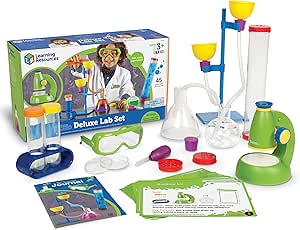 Perfect for curious little minds, this science kit introduces children to the wonders of observation and experimentation through playful, hands-on discovery. Equipped with all the essential tools, it invites young explorers to question, predict, and observe—laying the foundation for understanding the scientific method. A fun and engaging way to spark curiosity, build confidence, and inspire a lifelong love of science!
Perfect for curious little minds, this science kit introduces children to the wonders of observation and experimentation through playful, hands-on discovery. Equipped with all the essential tools, it invites young explorers to question, predict, and observe—laying the foundation for understanding the scientific method. A fun and engaging way to spark curiosity, build confidence, and inspire a lifelong love of science!
Toys for 4-Year-Olds
Four-year-olds are ready for toys that foster early learning in STEAM, creativity, and social skills. These toys introduce them to concepts like engineering, photography, and exploration while promoting physical activity and independent play.
- Gears Building Set
Skill Focus: STEAM Engineering skills, problem-solving
 A fun and hands-on way to introduce young children to STEAM learning! With colorful gears that spin, connect, and move, kids can design their own structures while discovering how simple mechanics work. As they experiment with different combinations, they strengthen fine motor skills, problem-solving abilities, and critical thinking—perfect for inspiring budding engineers to explore how things move and work together.
A fun and hands-on way to introduce young children to STEAM learning! With colorful gears that spin, connect, and move, kids can design their own structures while discovering how simple mechanics work. As they experiment with different combinations, they strengthen fine motor skills, problem-solving abilities, and critical thinking—perfect for inspiring budding engineers to explore how things move and work together. - Magnets Kit
Skill Focus: STEAM Scientific exploration, fine motor skills
 This exciting kit lets children explore the magic of magnetic forces through hands-on play and experimentation. With a variety of colorful magnet wands and tools, kids can test attraction and repulsion, make predictions, and observe how magnets interact—all while having tons of fun. A perfect way to spark curiosity and introduce early science concepts through engaging, playful exploration.
This exciting kit lets children explore the magic of magnetic forces through hands-on play and experimentation. With a variety of colorful magnet wands and tools, kids can test attraction and repulsion, make predictions, and observe how magnets interact—all while having tons of fun. A perfect way to spark curiosity and introduce early science concepts through engaging, playful exploration. - Walkie Talkies
Skill Focus: Communication skills, social skills
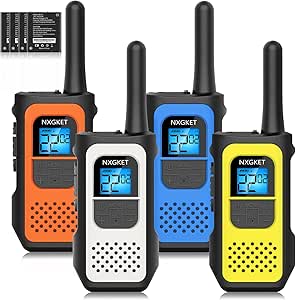 These fun and durable walkie-talkies inspire endless imaginative adventures while helping children build important communication and teamwork skills. Perfect for group play, they let kids stay connected as they explore indoors or outdoors, talking from room to room or across the yard. Built to last, these high-quality walkie-talkies are even used in our daycares to make communication between classrooms easy and efficient—proving they’re as practical as they are playful!
These fun and durable walkie-talkies inspire endless imaginative adventures while helping children build important communication and teamwork skills. Perfect for group play, they let kids stay connected as they explore indoors or outdoors, talking from room to room or across the yard. Built to last, these high-quality walkie-talkies are even used in our daycares to make communication between classrooms easy and efficient—proving they’re as practical as they are playful! - Digital Camera
Skill Focus: Creativity, fine motor skills
 A perfect first camera for young creators! This child-friendly digital camera lets kids explore their world through photography—capturing moments, discovering new perspectives, and expressing their creativity safely, without the need for a phone. Designed with easy-to-use buttons and a sturdy grip for little hands, it’s an ideal introduction to visual storytelling and a wonderful way to nurture imagination and observation skills.
A perfect first camera for young creators! This child-friendly digital camera lets kids explore their world through photography—capturing moments, discovering new perspectives, and expressing their creativity safely, without the need for a phone. Designed with easy-to-use buttons and a sturdy grip for little hands, it’s an ideal introduction to visual storytelling and a wonderful way to nurture imagination and observation skills. - Scooter
Skill Focus: Balance, coordination
 Perfect for energetic four-year-olds, this scooter helps little ones build confidence as they refine their balance, coordination, and strength. The lean-to-steer design makes it easy and intuitive to ride, encouraging body control and spatial awareness while promoting active outdoor play and independence.
Perfect for energetic four-year-olds, this scooter helps little ones build confidence as they refine their balance, coordination, and strength. The lean-to-steer design makes it easy and intuitive to ride, encouraging body control and spatial awareness while promoting active outdoor play and independence.
More Play Ideas in Parents Learn to Play Too
Each of these toys supports your child’s development in unique ways, combining learning and fun seamlessly. For even more play ideas and developmental activities, check out my book, Parents Learn to Play Too, available on Amazon! It’s full of creative, play-based activities that grow with your child. This holiday season, consider it as a gift for yourself or for someone you know with a young child—it’s a gift that keeps on giving all year round!
Fall Sensory Play Ideas for Kids
Fall Sensory Play Ideas for Kids
Fall is the perfect season to bring the magic of sensory play to life. The vibrant colors, cozy scents, and natural textures offer endless opportunities for hands-on learning — and the best part? You can set up these activities with simple, everyday materials you probably already have at home or in your classroom.
Whether you’re a parent, caregiver, or educator, these fun, affordable, and developmentally appropriate ideas will make learning through play a breeze.
Seasonal Sensory Bin Ideas
- Pumpkin Patch Bin 🎃
- What You Need: Dried corn kernels, mini pumpkins, small scoops, cups, and a shallow bin. If you have a child under 3, you can substitute the corn kernels with water, sand or shredded paper.
- How to Play: Children can scoop, pour, and “plant” the pumpkins while practicing fine motor skills.
- Apple Orchard Bin 🍎
- What You Need: Red pom-poms (to represent apples), cinnamon sticks for scent, small baskets, tongs/tweezers and scoops.
- How to Play: Encourage kids to “pick” the apples, count them, and sort them into the baskets.
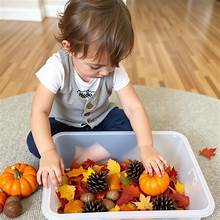
- Autumn Nature Hunt Bin 🍂
- What You Need: Real or faux leaves, pinecones, acorns, twigs, and magnifying glasses. Add some scoops, tongs/tweezers and plastic containers to sort the items.
- How to Play: Invite children to explore different textures and shapes while talking about colors, sizes, and patterns. Older kids can take on a sorting challenge and sort by colour, size or type of item.
Fall-Themed Sensory Play Recipes
Pumpkin Spice Play Dough ✨
Bring the smell of fall indoors with this cozy, hands-on activity that kids will love.
- What You Need: Flour, salt, cream of tartar, water, oil, orange food coloring, and pumpkin spice.
- How to Play: Roll, squish, and sculpt pumpkins, leaves, or letters for endless fun.
- Bonus: Watch this quick video for the play dough recipe and see how you can make homemade pumpkin spice play dough in just minutes.

Outdoor Sensory Adventures
Don’t forget — sensory play doesn’t have to stay indoors! Here are a few ways to take the learning outside this season:
- Leaf Crunch Walk 🍁
Take a walk and collect fallen leaves. Once you’re back, sort them by size, color, or shape. This simple activity builds vocabulary, observation, and sorting skills — plus, nothing beats the satisfying crunch of stepping on fall leaves.
- Nature Sound Hunt 🎧
Head outside with a simple checklist and invite kids to listen for the sounds of fall — rustling leaves, chirping birds, or the wind blowing through the trees. For younger children, keep it simple with picture prompts; older kids can check off or even draw what they hear.
- Pumpkin Washing Station 💦
Grab a few buckets, fill them with warm water, and add scrub brushes for a simple, engaging cleanup station. Kids will love washing and scrubbing small pumpkins while developing hand strength and coordination.

Mess-Free Sensory Options
Need something quick and cleanup-friendly? Try these simple, no-mess sensory setups:
Fall Sensory Bags 👜
- What You Need: Zip-top bags, water, glitter, leaves, and small seasonal items like faux flowers or mini acorns.
- How to Play: Fill the bag, seal tightly (tape edges for extra security), and secure it to a table or window. Children can squish, press, and explore without any mess.
- Bonus: Watch this quick video to see how you can make a sensory bag in just minutes.

Tip: Want more ideas like this? Get step-by-step guidance in my Sensory Play Made Simple mini-course — perfect for parents and educators looking for easy, play-based learning setups.
Final Thoughts
Fall is such a sensory-rich season — and the perfect time to explore the world through touch, sound, sight, and even smell. Whether you’re setting up a pumpkin patch sensory bin, heading outdoors for a leaf crunch walk, or creating a mess-free sensory bag, each of these activities helps children build important skills while having fun.
Ready to take your sensory play to the next level? Check out my Sensory Play Made Simple mini-course for more easy, affordable, and brain-boosting ideas that you can start using today.
Struggling to Support Your Child’s Learning at Home? Easy Mini-Courses Designed Just for Moms!
Struggling to Educate at Home? Easy Mini-Courses Designed Just for Moms!
I’m so excited to announce a brand-new lineup of mini-courses designed to give you the tools, confidence, and ideas to support early learning—without the overwhelm.
Whether you’re a parent, caregiver, or early childhood educator, these short and practical courses were created with you in mind. No fluff. No pressure. Just real strategies you can use right away.
Why Mini-Courses?
Because you’re busy—and you want quick wins that make a real impact.
Each course is:
✅ Short & focused
✅ Packed with useful, real-world ideas
✅ Designed to fit into your life—not take it over
✅ Budget-friendly and accessible anytime
These aren’t just courses—they’re confidence boosters.
🎉 What’s Inside? Here’s a Look at the Newest Mini-Courses:

📦 Sensory Play Made Simple
Hands-on learning for curious kids – made easy for moms.
Curious about sensory play but not sure where to start? You’re not alone—and this course is here to guide you.
You’ll learn:
- Why sensory play supports brain, body, and emotional development
- How sensory activities build focus, language, and motor skills
- How to create fun setups in under 10 minutes
- How to adapt activities for different ages, needs, and styles
Walk away feeling inspired and equipped to create powerful play experiences—using what you already have at home.
Click here to sign up.

🔤 Teach Letters with Confidence
Help your child fall in love with letters—no flashcards, just fun.
Forget the drills and pressure. This course helps you teach early literacy through joy, connection, and hands-on play.
You’ll learn:
- How letter learning really works
- Playful strategies that build confidence
- Ways to make letters part of everyday moments
Perfect for parents and caregivers who want to make early reading feel natural, not forced.
Click here to sign up.

🧠 Unlock the Secrets to How Children Learn
Learn how to nurture curiosity, creativity, and confidence at home.
This course dives into the brain science of how young children actually learn—through play, connection, and curiosity.
You’ll learn:
- Why curiosity is your child’s best learning tool
- How play outperforms repetition and drills
- How to turn everyday moments into meaningful learning
Ideal for parents, educators, and anyone who wants to support learning without stress.
Click here to sign up.

🔢 Teach Numbers with Confidence
Help your child build real number sense—no worksheets, just play.
If you’re unsure how to teach early math in a way that actually sticks, this course is for you.
You’ll learn:
- What number sense looks like in early childhood
- How to introduce counting, quantity, and number recognition
- Simple games and strategies to teach math through play
Great for educators and parents who want to ditch the flashcards and teach math the way kids learn best.
Click here to sign up.
🎓 Ready to Learn, Grow, and Play?
These mini-courses are designed to meet you right where you are—with real-world tools you can use the same day.
Whether you’re looking for fresh ideas or a little reassurance, I’ve got you.
👉 Explore the courses now. Click here to sign up.
Start anytime. Learn at your pace. Keep access for good.
Let’s make learning joyful again—because when adults feel confident, kids thrive.
Travel Tips for Moms of Kids Under 6: Surviving (and Enjoying!) the Journey
Travel Tips for Moms of Kids Under 6: Surviving (and Enjoying!) the Journey
Traveling with small children can feel like packing for a three-day hike just to visit Grandma — but with the right tips, you can trade the stress for smoother travel and even make some sweet memories along the way.
Whether you’re taking to the skies or hitting the road, here are mom-approved travel tips to keep your little ones happy and you (mostly) sane.
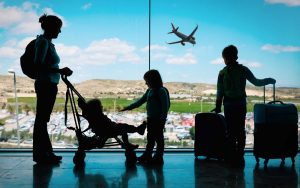
5 Airplane Travel Tips with Small Kids
Flying with toddlers or preschoolers? Deep breaths, mama — you’ve got this.
- Pick Flight Times Wisely
Aim for flights during nap time or early in the day when kids are at their best. Avoid red-eyes unless your child is a guaranteed sleeper.
- Bring All the Snacks (and Then Some)
Snacks are the ultimate distraction. Think: dry cereal, cut-up fruit, granola bars, crackers, and pouches. Bonus: chewing and swallowing during takeoff helps with ear pressure.
- Pack a Busy Bag
Fill a zippered pouch with:
- Sticker books
- Mini coloring pads
- Favourite small toys
- “Busy” activities
You can make your own “busy bag” activities. Click here for video ideas on what to include.
- Use Pull-Ups Even If They’re Potty Trained
Accidents happen when you’re in line for boarding or mid-air. No shame in being prepared.
- Bring a Lightweight Stroller or Baby Carrier
Gate-check a stroller and wear your child if needed. It makes airport transitions smoother and gives you a safe spot for them to rest.

5 Road Trip Travel Tips with Small Kids
Road trips with kids = flexibility, snacks, and a good playlist.
- Leave Early or Drive During Nap Time
Early morning or right before nap can give you some peaceful drive time. I love those 4 am drives when no one is on the road! If you child likes to sleep in the car, overnight driving is an option!
- Plan for Frequent Stops
Stop every 2–3 hours to stretch little legs, run around, and get some energy out.
- Backseat Entertainment
Use a lap tray or cookie sheet for coloring, magnet games, or even playdough (if you’re brave!).
- Create a “Car Activity Box”
Rotate a few new toys or books every hour to keep things fresh. Think busy bag! Click here for video ideas on what to include.
- Pack Essentials Within Reach
Have a bag within arms reach with:
- Wipes
- Extra clothes
- Snacks
- Water bottles
- Favorite comfort item

General Travel Tips for Any Trip with Kids Under 6
These tips work no matter where you’re headed:
- Prep Your Child in Advance
Use books or pretend play to explain what’s going to happen. “First we drive… then we wait in line… then we fly in the airplane…” You can role play this through pretend play in advance so there are no surprises.
- Lower Expectations
Don’t expect to do everything on your itinerary. Keep it simple, flexible, and follow your child’s lead.
- Stick to a Loose Routine
Try to maintain a nap and meal rhythm — even if it’s off by an hour or two — to help kids feel secure.
- Pack Smart (Not Just More)
Less is more when you’re juggling a toddler. Choose multi-purpose items, like:
- A large scarf (blanket, shade cover, nursing cover)
- Wet bags (for dirty clothes or garbage)
- Reusable water bottles and snack containers
- Don’t Forget You
Pack snacks, headphones, and something just for you — even if it’s a podcast or your favorite gum. You matter too, mama.
Traveling with young kids isn’t easy — but it’s worth it. The giggles in the backseat, the joy of seeing a new place through their eyes, the sweet snuggles on a plane — these moments become the memories that last.
And when things go sideways (because sometimes they do), remind yourself: You’re doing an amazing job.
April Showers Bring May Flowers: Rainy Day Play Ideas for Toddlers
April Showers Bring May Flowers: Rainy Day Activity Ideas for Toddlers
April’s rainy days don’t have to mean boredom for your little ones! While the wet weather may keep you indoors, it also provides the perfect opportunity to engage in fun and educational activities with your toddler. Here are some playful and enriching ways to make the most of rainy days while supporting your child’s learning and development.
- Indoor Obstacle Course 🏃♀️
Turn your living room into an exciting adventure course! Use pillows, chairs, cardboard boxes, and blankets to create a safe obstacle path. Crawling through boxes, jumping over cushions, and balancing on a tape line can enhance gross motor skills and coordination while keeping toddlers active indoors.
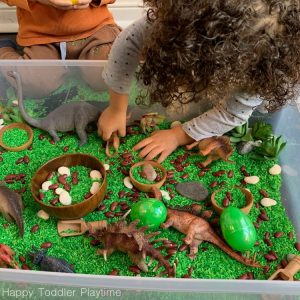
- Sensory Bin Fun 🌈
Bring a little bit of nature inside with a rainy-day sensory bin. Fill a plastic container with items like water beads, rice, or kinetic sand and add toy animals, measuring cups, and scoops for hands-on exploration. Sensory play helps with fine motor skills and cognitive development, while also providing a calming experience.
- DIY Rain Art 🎨
Take advantage of the rain by creating a fun science-meets-art activity! Let your child color on coffee filters with washable markers, then place them outside in the rain for a few moments to watch the colors blend and swirl. Once dry, you’ll have a beautiful, one-of-a-kind piece of art to display.

- Storytime Fort 📚
Build a cozy reading nook using blankets and pillows, then snuggle up for a storytelling session. Choose books with a rainy-day theme, such as The Rainy Day by Anna Milbourne or Raindrop, Plop! by Wendy Cheyette Lewison. Storytime helps build language skills, comprehension, and imagination.
- Bake Together 🍪
Turn your kitchen into a mini baking studio! Simple recipes like banana muffins or homemade granola bars offer a fun and tasty way to teach early math and science skills through measuring, mixing, and pouring. Plus, baking together encourages patience and following instructions.

- Puddle Play (With Proper Gear!) ☔
If the rain isn’t too heavy and it’s safe to go outside, embrace the weather! Dress your little one in rain boots and a waterproof jacket, then go outside for some good old-fashioned puddle jumping. This activity strengthens motor skills and allows for a fun sensory experience while enjoying nature’s wonders.
- Indoor Picnic 🧺
Bring the fun of an outdoor picnic inside! Lay out a blanket in your living room and enjoy lunch in a new setting. Pretend play like this fosters creativity and imagination while making mealtime more exciting.
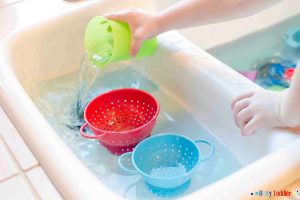
- Water Play in the Sink 💦
If your child loves playing with water, set up a “kitchen sink ocean.” Fill the sink with warm water, add some floating toys, cups, or a small colander, and let them explore pouring and splashing. Water play is a great way to encourage problem-solving and sensory exploration.
Final Thoughts 🌟
Rainy days don’t have to be dreary! With a little creativity, they can become magical opportunities for exploration, discovery, and connection. Whether you’re jumping in puddles, baking together, or enjoying a cozy book nook, these activities will keep your toddler engaged, learning, and having fun—rain or shine!
Follow Susie Beghin on Instagram or visit her website for more activity Ideas.
About the Author
Susie Beghin – Early Childhood Education Expert & Creator of the Raising Bright Early Learners System
Susie Beghin is a Registered Early Childhood Educator (RECE), author, and early childhood education thought leader dedicated to helping parents and educators give young children the best start in life. As the founder of the Raising Bright Early Learners System, Susie has developed a comprehensive program designed to empower stay-at-home moms and caregivers with the tools and confidence to provide high-quality early learning experiences at home.
With 20+ years of experience as a daycare owner and Founder of Alpha’s Discovery Kids Preschool and Daycare, and mom of a child with ADHD/autism, Susie understands the challenges parents face when it comes to early childhood education. Her expertise in STEAM-based learning, play-based education, and child development has allowed her to create a system that is both accessible and impactful for parents looking to nurture their child’s curiosity and cognitive growth.
Through her book, Parents Learn to Play Too, her popular ECE Classroom podcast, and hands-on training programs, Susie bridges the gap between professional early childhood education and practical, everyday parenting. The Raising Bright Early Learners System is built on the principles of inquiry, discovery, and exploration, helping parents create engaging learning environments that spark a lifelong love of learning in their children.
Whether through social media content, workshops, or personalized coaching, Susie is committed to making early learning simple, fun, and effective for families everywhere. Join her mission to raise bright early learners and feel confident in your child’s learning journey from the very start!
4 Easy Spring Sensory Play Ideas for Toddlers and Preschoolers
4 Easy Spring Sensory Play Ideas for Toddlers and Preschoolers
by Susie Beghin
Spring is a magical time for young children. The world is waking up, flowers are blooming, and new life is sprouting everywhere. It’s the perfect season to engage kids in sensory play — helping them explore the world through touch, smell, sight, sound, and even taste! Sensory play encourages discovery and inquiry, building essential skills like fine motor development, problem-solving, and language growth.
In this blog, I’ll share some fun and easy spring sensory play ideas, including creative gardening activities to get your little ones excited about the season.

🌱 1. Planting and Gardening Sensory Bins
Gardening is one of the best hands-on sensory experiences for kids. The feel of soil between their fingers, the smell of fresh herbs, and the sight of tiny green shoots create a rich sensory experience.
What You’ll Need:
- A shallow bin or tray (or sensory bin)
- Potting soil
- Small plastic pots
- Small gardening tools (like a spade or trowel)
- Seeds (like beans, sunflowers, or herbs)
- Small flowers
- Watering Can
How to Do It:
- Fill the bin with soil and let your child dig and explore.
- Encourage them to plant seeds and cover them with soil.
- Let them use a spray bottle to water the seeds.
- Observe how the seeds begin to sprout over the next few days.
Learning Boost: Talk about what plants need to grow (sunlight, water, soil) and introduce simple science terms like “germination.”

🌸 2. Flower Petal Sensory Soup
This colorful activity combines touch, sight, and smell for a multi-sensory experience.
What You’ll Need:
- A shallow bin, bowl or tray (or sensory bin)
- Water
- Flower petals (real or fake)
- Spoons, ladles, and small cups
How to Do It:
- Fill the bowl with water and add the flower petals.
- Let your child stir, scoop, and pour the “soup.”
- Encourage them to describe how the petals feel and smell.
Learning Boost: Introduce color names and texture words like “soft,” “smooth,” and “fragrant.”

🌼 3. Mud Kitchen
Let your child engage in messy play by creating a “mud kitchen” outdoors.
What You’ll Need:
- Dirt
- Water
- Old pots, pans, and kitchen utensils
- Leaves, grass, and flowers
How to Do It:
- Set up an outdoor play area with mud and kitchen tools.
- Encourage your child to mix mud “recipes” using leaves and flowers.
- Let them squish, mold, and pour the mud to create different textures.
Learning Boost: Discuss the difference between wet and dry mud and how adding water changes the texture.

🦋 4. Birds Exploration
Spring is a busy time for birds as they make their nests! Encourage kids to observe and explore these creatures and then create a bird sensory exploration indoors.
What You’ll Need:
- Shredded paper (green and brown)
- Bird’s nest and or bird house (you can make the nest or house as a craft activity with pieces of twigs or buy it from the dollar store)
- Toy birds
- Small toy eggs (plastic)
- Feathers
- Wood pieces (twigs and small wood cutouts)
- Brown yarn cut in small pieces (worms)
- Tweezers
How to Do It:
- Arrange a combination of green and brown paper on the bottom of the bin. Place the house and nest in the bin.
- Scatter the yarn worms around the paper and hide some underneath the “grass”.
- Place the eggs in the nest as well as the birds.
- Encourage your child “feed” the birds by using the tweezers to pickup the worms and feed them to the birds.
- Encourage open-ended play with your bird habitat.
Learning Boost: Discuss how birds make nests and take care of their young.
🌷 Why Sensory Play Matters
Spring sensory play helps children develop:
✅ Fine motor skills (through digging, pouring, and stirring)
✅ Language skills (by describing textures and smells)
✅ Cognitive growth (by observing plant growth and understanding natural cycles)
✅ Emotional regulation (sensory play is calming and helps reduce stress)
Spring is the perfect time to encourage discovery and exploration through sensory play. These simple but meaningful activities will spark your child’s natural curiosity and help them connect with the world around them.
For more ideas like this, visit YouTube !
7 Valentine’s Day-Themed Activities for Preschoolers
Love, Learning, and Little Hands: 7 Valentine’s Day-Themed Activities for Preschoolers
February is the perfect time to blend love and learning with engaging, hands-on activities. Learning through play fosters curiosity, creativity, and confidence in young children. This blog will explore STEAM, fine motor, sensory, literacy, and math activities—all with a Valentine’s Day twist!
STEAM Exploration: Science

1. Fizzing Heart Science
- Materials: Baking soda, water, vinegar, heart-shaped cookie cutters, food coloring
- Exploration: Mix baking soda with pink/red colored water, shape it into hearts using the cookie cutter. Let it dry and then drop it on a plate of vinegar and watch it fizz!
- Learning: Introduces simple chemical reactions and cause-and-effect.
2. Floating Hearts – A Surface Tension Experiment
- Materials: Dry-erase markers, white ceramic plate, water, straw or spoon
- Exploration: Draw small hearts on the plate with a dry-erase marker. Slowly pour a small amount of water onto the plate. Watch as the hearts lift off and float! Use a straw or spoon to gently move them around.
- Learning: Introduces kids to surface tension and water resistance. Encourages observation and prediction in a fun, hands-on way.
Fine Motor Fun: Strengthening Little Hands

3. Heart Threading Garland
- Materials: Yarn, hole-punched paper hearts, plastic needle
- Exploration: Encourage kids to thread paper hearts onto yarn to create a festive garland.
- Learning: Develops hand-eye coordination and fine motor control.
4. Valentine’s Day Playdough Invitation
- Materials: Pink/red playdough, heart-shaped cookie cutters, buttons, beads
- Exploration: Let kids press, roll, and shape the dough into fun Valentine’s-themed designs.
- Learning: Supports creativity and strengthens finger muscles for pre-writing skills.
Sensory Play: Engaging the Senses

5. Valentine’s Sensory Bin
- Materials: Dyed rice (red/pink) or pink/red shredded paper, heart-shaped objects, foam hearts, scoops, small containers
- Exploration: Let kids scoop, pour, and sort items in the bin.
- Learning: Encourages sensory exploration, sorting, and fine motor skills.
Literacy and Math Exploration
6. Heart Letter-Matching Game
- Materials: Paper or foam hearts with uppercase and lowercase letters
- Exploration: Cut hearts in half with one side having the uppercase letter and the other half with the matching lowercase letter. Kids match uppercase and lowercase letters to complete the heart.
- Learning: Reinforces letter recognition and early literacy.
7. Counting Hearts Game
- Materials: Paper hearts with numbers, small manipulatives (pom-poms, beads)
- Exploration: Children place the correct number of manipulatives on each numbered heart.
- Learning: Develops number sense and one-to-one correspondence.
Incorporating Valentine’s Day into learning offers a great opportunity to foster inquiry, discovery, and exploration at home. These activities make learning fun and meaningful while strengthening early childhood skills. This is a great way to embrace playful learning and enjoy quality time with your little ones.
Winter Activities for Kids: 10 Fun Ways to Explore, Discover, and Learn This Season
Winter Activities for Kids: 10 Fun Ways to Explore, Discover, and Learn This Season
Winter is a magical time for kids, with snowflakes swirling, frost on windows, and a chill in the air. But it can also be a challenging time for parents and caregivers in cold climates, as kids are often cooped up indoors. However, winter offers endless opportunities for fun, exploration, and learning—both indoors and outdoors. Here are 10 engaging winter activities that encourage inquiry, discovery, and creativity.
Outdoor Winter Activities
- Snow Painting Bring out your child’s inner artist by filling spray bottles with colored water (just a few drops of food coloring mixed with water) and letting them paint the snow. This activity is not only fun but also encourages creativity and fine motor skills.
- Frozen Nature Hunt Head outside with a basket and search for natural items like pinecones, twigs, and leaves. Bring them home and place them in a shallow tray filled with water. Leave the tray outside to freeze overnight, creating a nature-themed ice sculpture. This is a great way to spark curiosity about the changing seasons. Take out a small hammer and a spray bottle with warm water and have your child try to get the items out of the ice!
- Bird Feeder Craft Make a simple bird feeder using pinecones, peanut butter, and birdseed. Hang the feeders outside and watch as winter birds come to visit. This activity promotes an interest in wildlife and nature.
Indoor Winter Activities
- DIY Snow Globes Help your child make their own snow globe using a clear jar, water, glitter, and small figurines. This craft activity enhances creativity while also teaching basic science concepts about liquids and solids.
- Snowflake Symmetry Art Cut out paper snowflakes and use them to teach kids about symmetry. Once the snowflakes are cut, let them decorate each half with different colors or patterns to highlight their symmetrical design.
- Winter-Themed Story Time Cozy up with a blanket and read winter-themed books together. Follow up the reading session with a creative storytelling activity where kids make up their own winter adventure. Storytelling helps develop language skills and imagination.
Sensory Winter Play
- Indoor Snow Play Bring the snow indoors by filling a large bin with clean snow. Add small toys, scoops, and containers for sensory play. If you don’t have snow, you can create fake snow using baking soda and water and freeze it until it is the consistency of snow.
- Frozen Treasure Hunt Freeze small toys or objects in a block of ice, then let your child “excavate” them using warm water, droppers, and small tools. This is a fun way to build fine motor skills and introduce basic science concepts like melting and temperature.
- Winter Sensory Bin Create a sensory bin with cotton balls, white pom-poms, and small winter-themed toys. Add scoops, tongs, and containers for kids to explore textures and practice their fine motor skills.
Winter STEM Challenges
- Marshmallow Igloo Building Provide mini marshmallows and toothpicks for kids to construct their own igloos. This hands-on activity encourages engineering skills and spatial thinking.
Winter is a season full of possibilities for learning through play. By encouraging kids to explore the world around them—even when it’s cold outside—you nurture their natural curiosity and creativity. Whether it’s experimenting with snow, exploring nature or crafting unique snowflakes, these activities create lasting memories while supporting your child’s development.
So bundle up, gather some supplies, and let the winter fun begin!
For more winter activities, subscribe to Susie Beghin’s YouTube channel or follow on Instagram or Facebook.
Navigating Speech Delays in Early Childhood Education
The ECE Classroom – Episode 7- Navigating Speech Delays in Early Childhood Education
by Susie Beghin, RECE, Founder of Alpha’s Discovery Kids
In a recent episode of the ECE Classroom Podcast, I had the pleasure of speaking with Mary Plain, a dedicated speech and language pathologist from Hello Speech. Together, we explored some of the most important aspects of speech and language development in early childhood education. Our conversation was filled with valuable insights for parents, educators, and speech therapists alike, including early identification of speech delays, the benefits of intervention, and practical strategies for supporting young children’s language development.
Why Early Identification of Speech Delays Matters
One of the primary topics we covered was the critical importance of identifying speech delays early. Mary highlighted that some signs of speech and language delays can start to show as early as 18 months. When caught early, these delays are more easily addressed, often preventing potential difficulties down the road in both communication and academics. Early childhood is a crucial period of brain development and language acquisition, so recognizing and addressing delays early on can make a big difference in a child’s ability to thrive.
As educators and parents, we’re often in the best positions to observe these early signs, which makes understanding what to look for essential. Noticing if a child has limited vocabulary, difficulty following instructions, or struggles with using gestures to communicate can be the first step toward intervention that sets them up for future success.
 Understanding the Difference Between Speech and Language
Understanding the Difference Between Speech and Language
During our conversation, Mary clarified an important distinction that’s often overlooked: the difference between “speech” and “language.” While we sometimes use these terms interchangeably, they actually refer to separate aspects of communication. Speech is about the verbal sounds children make, while language includes both verbal and nonverbal communication skills—such as gestures, expressions, and comprehension.
This distinction is important for educators and parents to grasp, as it helps us to better understand and identify which areas of communication a child might need help with.
Destigmatizing Speech and Language Services
A key point that Mary emphasized was the need to destigmatize speech and language services. Many parents may feel hesitant or embarrassed about seeking help for their child, but speech services are beneficial for children across a range of developmental stages. There is a common misconception that speech therapy is only for children with severe challenges, but it can support various aspects of language development, even when delays are mild or just emerging.
One of our responsibilities as educators is to encourage open, empathetic conversations with parents about their child’s development. By normalizing speech services as a regular part of a child’s educational journey, we can make parents feel more comfortable seeking support and reinforce that early intervention is often in their child’s best interest.
 Strategies to Support Language Development
Strategies to Support Language Development
Mary provided several practical strategies for educators and parents to support language development, which I found especially helpful:
- Use Visual Aids: Picture cards, illustrated schedules, and other visual supports help children follow routines and understand instructions, especially if they’re struggling with receptive language.
- Model Gestures and Expressions: Using clear gestures and facial expressions helps children associate meaning with spoken words, enhancing their understanding of verbal communication.
- Encourage a Total Communication Approach: This approach emphasizes the use of any available communication methods—words, gestures, and visual aids—allowing children to express themselves in ways that feel natural to them.
- Promote Both Receptive and Expressive Language: Receptive language is about understanding spoken language, while expressive language is about sharing ideas. Activities like storytelling, following instructions, and encouraging children to describe their thoughts can help strengthen both areas.
- Foster Peer Interactions: Structured play and group activities encourage children to use both verbal and nonverbal communication, building confidence in their language abilities.
The Impact of Early Intervention and Collaboration
A major takeaway from this episode is that early intervention has a significant positive impact on children’s lives. When children receive support early, they’re more likely to hit developmental milestones, which in turn boosts their confidence, academic success, and social skills. Early intervention not only benefits the individual child but also enhances the classroom environment by promoting inclusive communication strategies.
Final Thoughts
My conversation with Mary Plain on the ECE Classroom Podcast underscored the profound role that speech and language development plays in early childhood education. By identifying speech delays early, implementing supportive strategies, and encouraging open discussions with parents, we can help children build a strong foundation in communication. Destigmatizing speech services and normalizing early intervention are steps that empower parents and educators to give children the support they need to thrive.
Stay tuned for more insightful discussions on early childhood education, parenting, and educator empowerment. Let’s continue to learn, grow, and make a difference in the lives of our students every day.
You can listen to the podcast on your favorite podcast platform, or by clicking here: https://open.spotify.com/show/7Hg7rTtRQggsVSCbbOdvP2?si=paCEPiCRRGK7yOfrTTsh8Q
Parenting Tips: The Power of Play
Unlocking Potential: The Power of Play in Parenting
by Susie Beghin, RECE, Founder of Alpha’s Discovery Kids
With so much on their plates these days, parents often find themselves juggling multiple responsibilities, leaving little time for meaningful interactions with their children. However, research shows that parental involvement is crucial for a child’s emotional and cognitive development. In this blog, we will explore how simple strategies can transform playtime into a powerful learning experience, even amidst the hustle and bustle of daily life. We’ll also address the growing concern of screen time and offer engaging alternatives that foster creativity and connection. Plus, don’t forget to check out my book, Parents Learn to Play Too, available on Amazon, for more insights and strategies!
Parent Involvement = Happy, Smart, Confident Kids; Simple Strategies for Impactful Playtime
When parents actively participate in their children’s play, it creates a nurturing environment where kids can thrive. Studies indicate that children with involved parents are happier, more intelligent, and more confident. Here are some simple strategies to maximize your playtime:
1. Be Present
Being physically present is essential, but emotional presence is equally important. Put away distractions like your phone or laptop. Engage in the activity at hand—whether it’s building blocks, playing dress-up, or drawing. Your undivided attention sends a powerful message: “You matter.”
2. Ask Open-Ended Questions
Encourage critical thinking and creativity by asking open-ended questions during play. Instead of simply asking, “How many cars do you have?” try asking, “What do you want to do with the cars?” This not only stimulates their imagination but also fosters problem-solving skills.
3. Incorporate Learning into Play
Transform everyday activities into learning opportunities. Cooking together? Talk about measurements and ingredients. Playing outside? Discuss the weather or observe nature. These subtle integrations of learning will enhance your child’s knowledge while making playtime fun.
4. Create Routines Around Play
Establishing a routine can make playtime a cherished part of your day. Whether it’s a dedicated hour after school or a weekend family game night, consistency helps children look forward to these moments and reinforces the importance of family bonding.
By implementing these strategies, you can create an enriching environment that promotes happiness, intelligence, and confidence in your children.
 No Extra Time to Play? No Problem; Make Every Moment a Learning Moment
No Extra Time to Play? No Problem; Make Every Moment a Learning Moment
Many parents feel overwhelmed by their busy schedules and believe they don’t have time for engaging activities with their kids. However, every moment presents an opportunity for learning! Here are some ways to incorporate educational experiences into your daily routine:
1. Utilize Commute Time
Whether you’re driving or taking public transport, turn your commute into an educational experience. Sing songs together in the car to encourage language development or count the number of white trucks you see. You can turn an ordinary drive into a fun math game.
2. Household Chores as Learning Opportunities
Involve your children in household chores while teaching them valuable life skills. Sorting laundry can become a lesson in colors and patterns; cooking can introduce math through measuring ingredients; cleaning can teach responsibility and teamwork.
3. Use Waiting Time Wisely
Whether you’re waiting at the doctor’s office or in line at the grocery store, use this time to engage with your child. Play simple games like “I Spy” or read books together to pass the time.
4. Bedtime Stories with a Twist
Instead of traditional bedtime stories, encourage your child to create their own tales using prompts or pictures from books you read together earlier in the day. This stimulates creativity while reinforcing literacy skills.
Remember, every moment spent together is an opportunity for growth and connection!
Too Much Screen Time? Let’s Fix That—with Engaging, Screen-Free Activities!
In an age dominated by screens, many children are spending excessive amounts of time on devices—often at the expense of physical activity and imaginative play. Here are some engaging, screen-free activities that will captivate your child’s attention:
1. Nature Scavenger Hunts
Go on a walk in nature and talk about what you see. Print out a list of nature items and try to find them.
2. Arts and Crafts
Set up a creative corner in your home with various supplies like paper, markers, glue, and recycled materials. Encourage your child to express themselves through art projects that can be displayed around the house.
3. DIY Science Experiments
Turn your kitchen into a science lab! Simple experiments like making play dough or baking soda volcanoes not only provide hands-on learning but also spark curiosity about how things work.
4. Building Forts
Utilize pillows, blankets, and furniture to create forts together! This activity promotes teamwork and imaginative play while providing a cozy space for reading or storytelling afterward.
By incorporating these screen-free activities into your routine, you can foster creativity and strengthen family bonds without relying on screens.
Parental involvement is key to raising happy, smart, and confident children. By embracing simple strategies during playtime and making every moment count—even amidst busy schedules—you can create lasting memories that enrich your child’s development.
For more insights and activity ideas on how to engage with your child through play effectively, be sure to check out my book Parents Learn to Play Too, available on Amazon! Together we can unlock the incredible potential within our children through the power of play!












